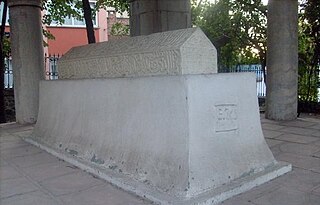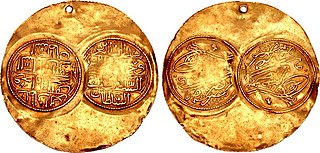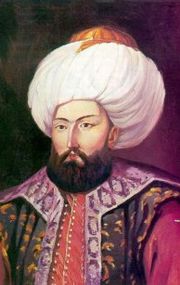Year 1492 (MCDXCII) was a leap year starting on Sunday of the Julian calendar.

The Karamanids, also known as the Emirate of Karaman and Beylik of Karaman, was one of the Anatolian beyliks, centered in South-Central Anatolia around the present-day Karaman Province. From the mid 14th century until its fall in 1487, the Karamanid dynasty was one of the most powerful beyliks in Anatolia.

The Russo-Ottoman War of 1710–1711, also known as the Pruth River Campaign, was a brief military conflict between the Tsardom of Russia and the Ottoman Empire. The main battle took place during 18-22 July 1711 in the basin of the Pruth river near Stănilești after Tsar Peter I entered the Ottoman vassal Principality of Moldavia, following the Ottoman Empire’s declaration of war on Russia. The ill-prepared 38,000 Russians with 5,000 Moldavians, found themselves surrounded by the Ottoman Army under Grand Vizier Baltacı Mehmet Pasha. After three days of fighting and heavy casualties the Tsar and his army were allowed to withdraw after agreeing to abandon the fortress of Azov and its surrounding territory. The Ottoman victory led to the Treaty of the Pruth which was confirmed by the Treaty of Adrianople.
Atçalı Kel Mehmet Efe (1780–1830) was a Zeybek who led a local revolt against Ottoman authority and established control of the Aydın region for a short period between 1829 and 1830.
Mehmed is the most common Bosnian and Turkish form of the Arabic name Muhammad and gains its significance from being the name of Muhammad, the prophet of Islam. Originally the intermediary vowels in the Arabic Muhammad were completed with an e in adaptation to Turkish phonotactics, which spelled Mehemmed, Mehemed, Mehmed and the name lost the central e over time Final devoicing of d to t is a regular process in Turkish. The prophet himself is referred to in Turkish using the archaic version, Muhammed.
Nicholas II Zorzi or Giorgi was the Margrave of Bodonitsa, a member of the Zorzi family of the Republic of Venice, from 1410 to 1414. He was the last Venetian margrave to actually rule before the Ottoman Turkish conquest.

Devlet Hatun was a concubine of Sultan Bayezid I, and the mother of Mehmed I of the Ottoman Empire.
A Polish–Ottoman alliance, based on several treaties, occurred during the 16th century between the kingdom of Poland-Lithuania and the Ottoman Empire, as the Ottomans were expanding into Central Europe.

The following outline is provided as an overview of and topical guide to the Ottoman Empire:

Baltacı Mehmet Pasha was an Ottoman statesman who served as grand vizier of the Ottoman Empire, first from 1704 to 1706 and again in 1710 to 1711, and as Kapudan Pasha in 1704.

Koca Mehmet Ragıp Pasha (1698–1763) was an Ottoman statesman who served as a civil servant before 1744 as the provincial governor of Egypt from 1744 to 1748 and Grand Vizier from 1757 to 1763. He was also known as a poet. His epithet Koca means "great" or "giant" in Turkish.

Musa Çelebi was an Ottoman prince and a co-ruler of the empire for three years during the Ottoman Interregnum.
Derviş Mehmed Pasha, an Ottoman Bosnian statesman, served briefly as the Grand Vizier of the Ottoman Empire between 21 June 1606 and 9 December 1606.
Hadım Mehmed Pasha was a Georgian Ottoman statesman. He was Grand Vizier of the Ottoman Empire between 21 September 1622 and 5 February 1623. He was also the Ottoman governor of Egypt from 1604 to 1605.

Süleyman Çelebi was an Ottoman prince and a co-ruler of the Ottoman Empire for several years during the Ottoman Interregnum. There is a tradition of western origin, according to which Suleiman the Magnificent was "Suleiman II", but that tradition has been based on an erroneous assumption that Süleyman Çelebi was to be recognised as a legitimate sultan.
Mehmet II of Karaman, Mehmed Beg, Mehmed Beg II, also known as Nasir al-Din Mehmed Beg was the ruler of Karaman in what is now modern Turkey in the 15th century. His mother was Nefise Hatun, a daughter of Sultan Murad I.

The Jagiellonian or Jagellonian dynasty, otherwise the Jagiellon dynasty, the House of Jagiellon, or simply the Jagiellons, was the name assumed by a cadet branch of the Lithuanian ducal dynasty of Gediminids upon reception by Jogaila, the Grand Duke of Lithuania, of baptism as Władysław in 1386, which paved the way to his ensuing marriage to the Queen Regnant Jadwiga of Poland, resulting in his ascension to the Crown of the Kingdom of Poland as Władysław II Jagiełło, and the effective promotion of his branch to a royal dynasty. The Jagiellons reigned in several European countries between the 14th and 16th centuries. Members of the dynasty were Kings of Poland (1386–1572), Grand Dukes of Lithuania, Kings of Hungary, and Kings of Bohemia and imperial electors (1471–1526).

Safranbolulu Izzet Mehmet Pasha was a grand vizier of the Ottoman Empire and served from 1794 to 1798.

Pertev Mehmet Paşa Mosque, also known as Yeni Cuma Cami meaning "New Friday Mosque" in Turkish, is a 16th-century Ottoman mosque in the town of Izmit, Turkey. The architect was Mimar Sinan. It was built for Pertev Mehmed Paşa, an Ottoman vizier during the reigns of sultan Suleyman I and Selim II. The construction was finished in 1579. The mosque is part of a larger complex (Külliye) which originally included a madrasa, hammam, caravanserai, fountain and a lower education school. The mosque itself is a single domed structure and the dome has 24 windows. The minaret was damaged during the 1999 İzmit earthquake.
Mihrimah Sultan was an Ottoman princess, daughter of Sultan Murad III and Safiye Sultan, and sister of Sultan Mehmed III of the Ottoman Empire.












